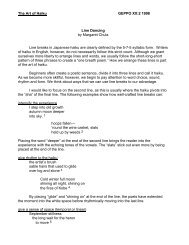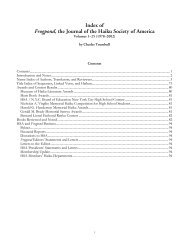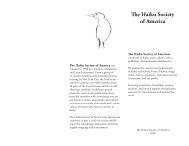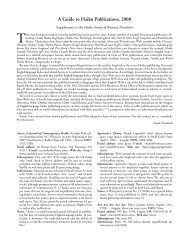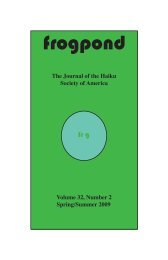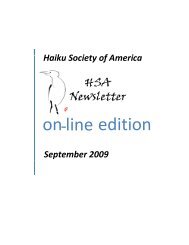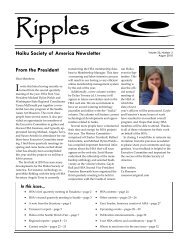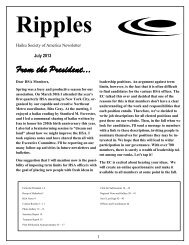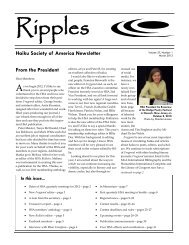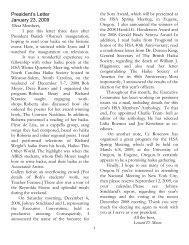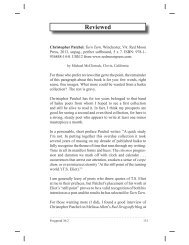Frogpond 34.3 • Autumn 2011 (pdf) - Haiku Society of America
Frogpond 34.3 • Autumn 2011 (pdf) - Haiku Society of America
Frogpond 34.3 • Autumn 2011 (pdf) - Haiku Society of America
You also want an ePaper? Increase the reach of your titles
YUMPU automatically turns print PDFs into web optimized ePapers that Google loves.
And where do you see this essay fitting in among other considerations<br />
specifically focused on Bashō’s life and work (Robert<br />
Aiken’s A Zen Wave; Haruo Shirane’s Traces <strong>of</strong> Dreams;<br />
and Makoto Ueda’s Bashō and His Interpreters come to mind<br />
among others)?<br />
JANE: Those books are indispensable, and many were part<br />
<strong>of</strong> my own introduction to haiku and, I’ll add, to poetry as a<br />
whole: the first book <strong>of</strong> any kind I ever bought for myself, at<br />
age eight, was a Peter Pauper Press book <strong>of</strong> translated Japanese<br />
haiku. We should add also the many translations <strong>of</strong> Bashō’s<br />
poetry now in print. I recommend them all—I think that to<br />
understand anything, especially when there are large leaps <strong>of</strong><br />
culture and time and translation involved, the most accurate<br />
understanding comes from looking at multiple sources. There<br />
is no single “best” authority. If you can’t read Bashō, Issa,<br />
Buson, or Yosano Akiko in the original, then reading them<br />
through many eyes is best.<br />
As for how my contribution fits in, The Heart <strong>of</strong> <strong>Haiku</strong> was<br />
retitled by Amazon when they took it for the Kindle Singles<br />
program; my title was Seeing Through Words: Matsuo Bashō,<br />
an Introduction. I think that tells you quite a lot about how I<br />
see this piece: I would never myself have made such a grand<br />
claim for it as The Heart <strong>of</strong> <strong>Haiku</strong> does. My piece is introductory,<br />
not exhaustive, and its angle <strong>of</strong> entrance is historical,<br />
through Bashō, not haiku in general, though to read Basho<br />
you have to understand what haiku are, and how they work,<br />
and what they can hold at their best. Bashō himself, though,<br />
is a perennially useful lens, since haiku as we now know it<br />
was so radically changed by Bashō, generally described as its<br />
“founder,” even though the form existed before him. For current,<br />
<strong>America</strong>n writers <strong>of</strong> haiku, The Heart <strong>of</strong> <strong>Haiku</strong> is really a<br />
way to look back to the rootstock, to refresh their relationship<br />
with how haiku was first conceived by its extraordinarily radical<br />
and continually evolving founding figure. Bashō himself<br />
was concerned with so many <strong>of</strong> the issues that current haiku<br />
writers are concerned with—how to write in this moment’s<br />
language and perception, how to learn from the past without<br />
. . . . . . . . . . . . . . . . . . . . . . . . . . . . . . . . . . . . . . . . . . . . . . . . . . . . . . . . . . . .<br />
66 <strong>Haiku</strong> <strong>Society</strong> <strong>of</strong> <strong>America</strong>



